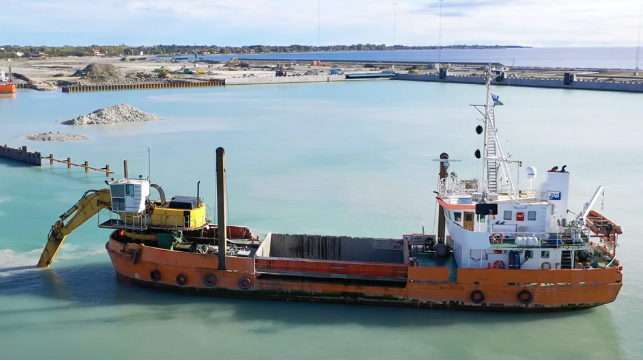Report: Capsized Dredger Routinely Operated With Decks Awash

The Danish Maritime Accident Investigation Board (DMAIB) has completed its inquiry into the capsizing of the bucket dredger Margrethe Fighter, concluding that the vessel was vulnerable to flooding and loss of stability because she was sailing heavily laden with full ballast tanks. The crew was in the habit of loading and trimming the ship in such a manner that parts of the foredeck were under water at times, and the investigators found that they had become accustomed to this practice as a matter of routine, to the point that they were aware of a need to maneuver gently and carefully.
In August 2020, Margrethe Fighter started work on a long-term dredging project in the Port of Trelleborg, Sweden. On February 17, 2021 - the day of the casualty - she started work at about 0630. Her three-man crew's division of responsibilities had the excavator operator take command of loading the vessel, and the deckhand would unload at the dump site. The captain was responsible for navigating between work sites and maneuvering the vessel during operations.
By 1330, the ship had made two trips to the dump site, and the excavator master was filling the hold with wet mud for the third time of the day. The depth on the site was about 29 feet, nearly the maximum reach of the excavator but just shy of the target depth for the job. To keep working, the Margrethe Fighter's forward ballast tanks were filled in order to lower the bow and extend the depth that the excavator arm could access.
As the cargo hold filled up to the halfway point, the excavator operator let the captain know that it was time to drain the ballast tanks. He kept loading, and when the hold was laden so heavily that water could be seen on the foredeck, the excavator operator determined that the vessel was ready to transit and unload at the dump site. Based on a reconstruction, the DMAIB estimated that at this point the vessel was trimmed by the head by about 2.5 feet.
He placed the excavator bucket to port of the centerline because the ship had a slight starboard list, after which he went back to the deckhouse. The skipper raised the vessel's spuds and began the 15-minute voyage towards the dump site. At some point prior, he had gone to the engine room to open the discharge valves for the forward ballast tanks and started the fire pump (not the larger ballast pump) to deballast.
During the relocation voyage, the deckhand went out on deck to get ready to unload. He noticed that the ship was deeper in the water than usual, and he used an under-deck passage to get to the bow, as there was water on deck.
The excavator operator stayed in the deckhouse. Suddenly he noticed that the ship began to list to starboard in an unusual way, so he went up to the wheelhouse, where he saw that the skipper was in the process of turning to port. They had a brief conversation about what was wrong, since the ship did not usually move in this way.
From the wheelhouse, the excavator operator could see that water was coming onto the foredeck and that the bow was sinking farther and farther down. Recognizing the danger, the skipper tried to save the situation by turning the ship to starboard.
Out on deck, the deckhand noticed that the ship was listing heavily towards the starboard side. He heard the excavator operator shout to him to move the shovel of the excavator over to port side to counterbalance the list. The helmsman feared that the ship was about to capsize, so instead of entering the excavator cab, he crawled up on top of the machine in order to get away from the ship quickly when she went over.
The excavator operator also realized what was about to happen, and he hurried out of the door on the starboard side of the wheelhouse. He shouted to the master to get out too, but at that moment, the vessel capsized. She rolled through 180 degrees and stayed afloat, hull pointing up.
The deckhand and excavator operator managed to get away from the vessel after the capsizing and were rescued. The Margrethe Fighter was salvaged seven days later, and the master's body was recovered from the wheelhouse.
During the course of the accident investigation, the surviving crewmembers told DMAIB that they did not recall seeing any draft measurements or stability calculations performed on board. A logbook from a previous voyage did not contain exact information about the vessel's stability condition.
On previous voyages, the crew had debated the wisdom of navigating with the foredeck partially under water, but this operating method had been used before on other projects and there was no shoreside oversight to prohibit the practice. According to DMAIB, there was no daily coordination between the project management team and the company's marine technical staff, and operational decisions were left up to the crew.
"The ship capsized in a normal operating situation for the crew, where parts of the deck were under water because the cargo box was full and at the same time there was water in the front ballast tanks to trim the ship forward during the dredging work. This resulted in the ship having significantly impaired stability," concluded DMAIB. "It was the application of the ballast tanks as part of the ship's dredging practice that became crucial to the accident. . . . The investigation has shown that the crew did not find time to empty the ballast tanks before the relocation voyage."
